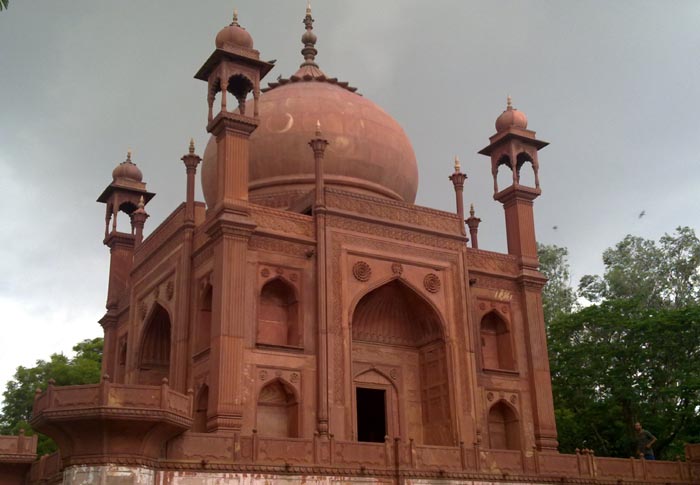Hessing's Tomb

Information on Hessing's Tomb (Agra, Uttar Pradesh) - History & Architecture
Hessing's Tomb is a historical monument, created for the memory of royal John William Hessing. He was a Dutch colonel who passed away in the year 1803. This tomb was created for memorising him, by Ann Hessing, the wife of John William Hessing. Hessing's Tomb is located in Agra on 3.4 meter tall rectangular stage encompassing an underground compartment. Hessing's Tomb is also known as 'Red Taj' since, it is created by red sandstone and is quite similar to the design of 'Taj Mahal'.
Hessing's Tomb Architecture
Hessing's Tomb was created on the basis of Mughal architectural format. It has four octagonal stages which are linked with four corners of the monument. One of the stages of Hessing's Tomb rises toward the walkway through twin staircases which are situated on the western portion of the tomb. Every side of the tomb possesses an iwan with two rectangular turrets which are capped by pinnacles. The turrets are capped by square structures and vertical fluting. On the top of the tomb, there lies the dual dome which possesses an upturned lotus design with a 'kalash' type finial. In the central compartment of the tomb, there remains a stone memorial, having certain captions, written in English language.
Hessing's Tomb is about 28 feet high and the interior compartment is about 17 feet lateral with beams and square soffit. The tomb reposes elegantly within the highpoints and it has umbrella shaped structure in the turrets. As a whole, Hessing's Tomb is seamlessly balanced with lovely construction. Thus, sometimes, it is precisely named as 'The Taj in Miniature'.
Hessing's Tomb History
Hessing's Tomb actually dates back to colonial era. William Hessing was a Dutch casual explorer who participated in the 'battle of Kandy' in the year 1765. He was a soldier, engaged in Dutch East India Company. He fought for this company against the British rulers, but British people ultimately conquered the Dutch forces in the year 1781 and seized every Dutch properties in India.
Hessing was quite absorbed by the abhorrence against British and therefore he started serving the Nizam dynasty of Hyderabad. In the year 1784, Hessing arrived at the service of King Mahadji Sindhia and complemented him to Pune. After the death of King Mahadji in the year 1794, Hessing arrived at Agra which was then ruled by Marathas. His service was remunerated by Marathas with rendering impressive authority over Agra Fort, which he controlled for about two decades. Hessing died in the year 1803, by protecting Agra Fort against the attack of British people. Afterwards, the fort was captured by British.
After his death, his wife decided to create a tomb according to the design of Taj Mahal. However, due to insufficient funds, she decided to use red sandstone in place of marble for the construction. Furthermore, there was also not enough fund to create four turrets in four sides of the tomb. Thus, it can be observed that the base for turrets could not be built.
Hessing's Tomb Tourism Importance
Hessing's Tomb is in reality one of the most beautiful tombs in India which makes it important place from tourism viewpoint. Although it is a Dutch tomb, it possesses the essence of Agra. It highlights the endurance of Mughal thoughts and skills of 19th century, thus makes it a great place to visit. Travellers can find it quite interesting to explore Hessing's Tomb as it gives a finest example of European as well as Islamic design.
- Andaman Nicobar Monuments
- Andhra Pradesh Monuments
- Assam Monuments
- Bihar Monuments
- Chhattisgarh Monuments
- New Delhi Monuments
- Goa Monuments
- Gujarat Monuments
- Haryana Monuments
- Himachal Pradesh Monuments
- Jammu and Kashmir Monuments
- Karnataka Monuments
- Kerala Monuments
- Madhya Pradesh Monuments
- Maharashtra Monuments
- Odisha Monuments
- Punjab Monuments
- Rajasthan Monuments
- Tamil Nadu Monuments
- Telangana Monuments
- Uttar Pradesh Monuments
- West Bengal Monuments